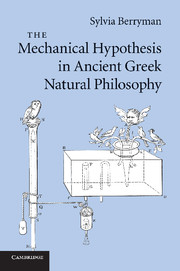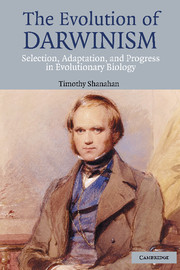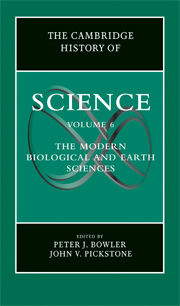Refine search
Actions for selected content:
10306 results in History of science: general interest
Bibliography
-
- Book:
- Numerical Notation
- Published online:
- 18 May 2010
- Print publication:
- 18 January 2010, pp 439-470
-
- Chapter
- Export citation
13 - Conclusion
-
- Book:
- Numerical Notation
- Published online:
- 18 May 2010
- Print publication:
- 18 January 2010, pp 430-434
-
- Chapter
- Export citation

The Mechanical Hypothesis in Ancient Greek Natural Philosophy
-
- Published online:
- 24 December 2009
- Print publication:
- 06 August 2009

The Evolution of Darwinism
- Selection, Adaptation and Progress in Evolutionary Biology
-
- Published online:
- 18 December 2009
- Print publication:
- 15 March 2004
The problem of raccoon intelligence in behaviourist America
-
- Journal:
- The British Journal for the History of Science / Volume 43 / Issue 3 / September 2010
- Published online by Cambridge University Press:
- 17 December 2009, pp. 391-421
- Print publication:
- September 2010
-
- Article
- Export citation
Test objects and other epistemic things: a history of a nanoscale object
-
- Journal:
- The British Journal for the History of Science / Volume 43 / Issue 3 / September 2010
- Published online by Cambridge University Press:
- 17 December 2009, pp. 423-458
- Print publication:
- September 2010
-
- Article
- Export citation

The Cambridge History of Science
-
- Published online:
- 28 November 2009
- Print publication:
- 13 April 2009
BJH volume 42 issue 4 Cover and Back matter
-
- Journal:
- The British Journal for the History of Science / Volume 42 / Issue 4 / December 2009
- Published online by Cambridge University Press:
- 26 November 2009, pp. b1-b4
- Print publication:
- December 2009
-
- Article
-
- You have access
- Export citation
Constance Areson Clark, God or Gorilla: Images of Evolution in the Jazz Age. Baltimore: Johns Hopkins University Press, 2008. xviii+289. ISBN 978-0-8018-8825-0. £23.50 (hardback).
-
- Journal:
- The British Journal for the History of Science / Volume 42 / Issue 4 / December 2009
- Published online by Cambridge University Press:
- 26 November 2009, pp. 608-609
- Print publication:
- December 2009
-
- Article
- Export citation
Stuart Clark, Vanities of the Eye: Vision in Early Modern European Culture. Oxford: Oxford University Press, 2007. Pp. xii+415. ISBN 978-0-19-925013-4. £35.00 (hardback).
-
- Journal:
- The British Journal for the History of Science / Volume 42 / Issue 4 / December 2009
- Published online by Cambridge University Press:
- 26 November 2009, pp. 603-604
- Print publication:
- December 2009
-
- Article
- Export citation
Henry J. Noltie, Robert Wight and the Botanical Drawings of Rungiah and Govindoo. 3 vols. Edinburgh: Royal Botanic Gardens Edinburgh, 2008. Pp. 215, 208 and 88. ISBN 978-1-906129-02-6. £75.00 (paperback, boxed set).
-
- Journal:
- The British Journal for the History of Science / Volume 42 / Issue 4 / December 2009
- Published online by Cambridge University Press:
- 26 November 2009, pp. 606-608
- Print publication:
- December 2009
-
- Article
- Export citation
Books received
-
- Journal:
- The British Journal for the History of Science / Volume 42 / Issue 4 / December 2009
- Published online by Cambridge University Press:
- 26 November 2009, pp. 635-637
- Print publication:
- December 2009
-
- Article
- Export citation
Margareta Tillberg, Tsvetnaia vselennaia: Mikhail Matiushin ob iskusstve i zrenii. Transl. from English by D. Dukhavina and M. Iarosh. Moscow: Novoe Literaturnoe Obozrenie, 2008. pp. 512. ISBN 978 5 867 93600 6. No price given (paperback).
-
- Journal:
- The British Journal for the History of Science / Volume 42 / Issue 4 / December 2009
- Published online by Cambridge University Press:
- 26 November 2009, pp. 609-611
- Print publication:
- December 2009
-
- Article
- Export citation
Aileen Fyfe and Bernard Lightman (eds.), Science in the Marketplace: Nineteenth-Century Sites and Experiences. Chicago and London: University of Chicago Press, 2007. Pp. x+410. ISBN 978 0 226 27650 2. $45.00, £23.50 (hardback).
-
- Journal:
- The British Journal for the History of Science / Volume 42 / Issue 4 / December 2009
- Published online by Cambridge University Press:
- 26 November 2009, pp. 621-623
- Print publication:
- December 2009
-
- Article
- Export citation
Steven Shapin, The Scientific Life: A Moral History of a Late Modern Vocation. Chicago and London: University of Chicago Press, 2008. Pp. xvii+468. ISBN 978-0-226-75024-8. $29.00 (hardback).
-
- Journal:
- The British Journal for the History of Science / Volume 42 / Issue 4 / December 2009
- Published online by Cambridge University Press:
- 26 November 2009, pp. 632-634
- Print publication:
- December 2009
-
- Article
- Export citation
BJH volume 42 issue 4 Cover and Front matter
-
- Journal:
- The British Journal for the History of Science / Volume 42 / Issue 4 / December 2009
- Published online by Cambridge University Press:
- 26 November 2009, pp. f1-f2
- Print publication:
- December 2009
-
- Article
-
- You have access
- Export citation
Marianne Sommer, Bones and Ochre: The Curious Afterlife of the Red Lady of Paviland. Cambridge, MA and London: Harvard University Press, 2007. Pp. xii+398. ISBN 978-0-674-02499-1. £25.95 (hardback).
-
- Journal:
- The British Journal for the History of Science / Volume 42 / Issue 4 / December 2009
- Published online by Cambridge University Press:
- 26 November 2009, pp. 619-620
- Print publication:
- December 2009
-
- Article
- Export citation
Steven McClean, The Early Fiction of H. G. Wells: Fantasies of Science. Basingstoke: Palgrave Macmillan, 2009. Pp. ix+242. ISBN 978-0-230-53562-6. £50.00 (hardback).
-
- Journal:
- The British Journal for the History of Science / Volume 42 / Issue 4 / December 2009
- Published online by Cambridge University Press:
- 26 November 2009, pp. 623-624
- Print publication:
- December 2009
-
- Article
- Export citation
Angela N. H. Creager, Elizabeth Lunbeck and M. Norton Wise (eds.), Science without Laws: Model Systems, Cases, Exemplary Narratives. Durham, NC and London: Duke University Press, 2007. ISBN 978-0-8223-4068-3. £12.99 (paperback).
-
- Journal:
- The British Journal for the History of Science / Volume 42 / Issue 4 / December 2009
- Published online by Cambridge University Press:
- 26 November 2009, pp. 626-628
- Print publication:
- December 2009
-
- Article
- Export citation
Claus Zittel, Gisela Engel, Romano Nanni and Nicole C. Karafyllis eds., Philosophies of Technology: Francis Bacon and His Contemporaries. Intersections: Yearbook for Early Modern Studies series vol. 11. Leiden: Brill, 2008. 2 vols. Pp. xxix+577. ISBN 978-9-0041-70506. €149.00 (hardback).
-
- Journal:
- The British Journal for the History of Science / Volume 42 / Issue 4 / December 2009
- Published online by Cambridge University Press:
- 26 November 2009, pp. 616-617
- Print publication:
- December 2009
-
- Article
- Export citation
